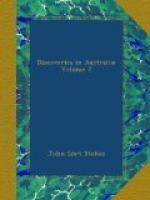EXPLORE AN OPENING.
July 30.
The morning broke with a strong breeze from South-South-East and although the temperature was not below 52 degrees, we were all shivering with cold. Soon after daylight we entered the opening, which for three miles was almost straight, in a South by West direction, with a width of two hundred yards, and a depth of from 2 1/2 to 5 fathoms. The banks were fringed with mangroves, behind which stretched extensive mud flats, which from being encrusted with salt and glistening in the sun were mistaken at first for sheets of water.
The inlet now became slightly tortuous, pursuing a general South-West by South direction; but the width being greater our hopes rose as we proceeded. Eight miles from the mouth two islands were passed, and two others four miles further on. The breadth at this point was nearly a mile, but the depth was scarcely two fathoms; one less than we had before found it. The above-mentioned islets, one of which was of some size, lay at the upper end of a reach, trending south, where this inlet or river, as we anxiously hoped it would prove to be, divided into two branches, one continuing in a southerly direction, and the other turning short off to the westward.
EXAMINE THE SOUTHERN BRANCH.
Though the latter had a greater volume of water passing through it than the other, I still, from the direction and size of the south arm, decided on ascending it first. For some distance the banks had been less fringed with mangroves, leaving clear patches covered with coarse grass. The trees on the side of the first reach in the southerly arm were laden with the snowy plumage of a large flock of cockatoos. After proceeding about five miles further we rested a few hours, continuing again soon after midnight. As the tides run twelve hours each way, it was necessary that we should take advantage of the favourable stream, whatever might be the hour, though this plan kept the men for a very long time together at the oars.
The general direction we pursued was still south, for six miles by the windings of the stream, which was so reduced in breadth and volume, as to be scarcely a hundred yards wide, and not a fathom deep. There was now little hope that it would lead into fresh water, although, from the number of trials that were made, I am sure there was salt water enough drunk to have physicked a whole village.
APPEARANCE OF THE COUNTRY.
The banks were still of the same monotonous character. In one of the reaches I was fortunate enough to shoot a specimen of the large wary brown-coloured rail I have before mentioned. From this, the only one obtained, it has been described as Eulabeornis castaneoventris. It is doubtless the bird called by the Port Essington natives, Morduggera, the eggs only of which were found there, the bird itself not having been seen. They were equal in size to those of a guineafowl, of a dirty white, finely speckled with reddish brown.




